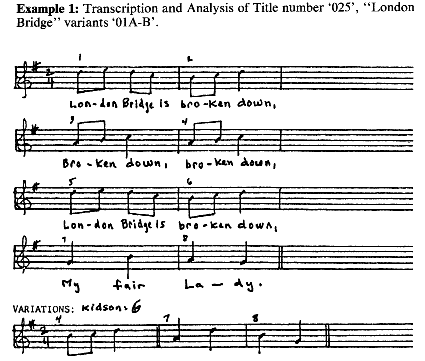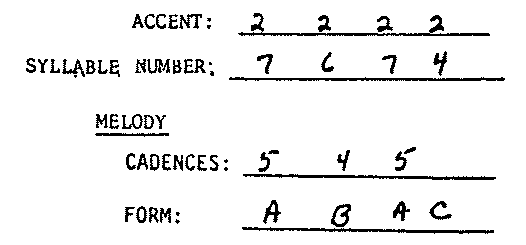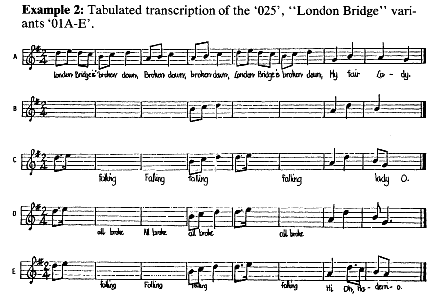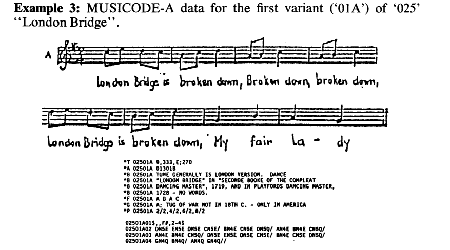
Canadian Journal for Traditional Music (1988)
Analysis and Clasification of British-Canadian Children's Traditional Singing Games
This study was conceived to provide a rationale for the selection of song materials for an elementary school music education program for Canadian children. This program is one based on an adaptation of the curriculum developed in Hungarian schools by colleagues of Zoltán Kodály.
In 1966 I was personally invited by Kodály to visit Hungary to study the music education program. He had observed my teaching that year at the Royal Conservatory Summer School in Toronto. In 1967 I went to Hungary, and during three years observed all aspects of teaching and teaching training, studied the curriculum of the kindergarten and elementary schools, practice taught, learned the Hungarian language and translated portions of Kodály's Visszatekintés, and studied methods of folk-song research and analysis with Dr. László Vikár of the Folk Music Research Group, Hungarian Academy of Sciences. I then returned to Canada in 1970 to develop a music education program for Canadian children based on the Hungarian model.
To accomplish this, I needed to know what the traditional songs of Canadian children were and then to analyze them to discover their common musical characteristics. For Hungarian schools, the curriculum had been structured according to the common musical characteristics of Hungarian children's songs, beginning with the simplest melodic and rhythmic elements of the song form. These had been determined from the collection of more than a thousand variants of children's songs published as Vol. I of Kerényi's . Magyar Népzene Tára. There, melodies were grouped according to similarity of melodic fragment within a hexachord framework that formed the nucleus of each melody. From this collection, songs were selected for teaching purposes, and through trial and error, those containing specific musical motives or phrases were selected to develop the instructional approach for schools.
When I returned to Canada in 1970 I began to compile variants of Canadian children's song literature. At first I was skeptical that such a body of literature existed, comparable to that of Hungarian children.
However, while in Hungary, I examined a copy of Walter Crane's The Baby's Opera, and Alice Bertha Gomme's The Traditional Games of England, Scotland, and Ireland. I then studied the Opies' Oxford Dictionary of Nursery Rhymes, and was surprised to find reference to various original sources that contained melodies accompanying some of the texts that they printed. I located many of these original sources which were printed in Britain in the Osborne Collection of Early Children's Books of the Boys and Girls House, Toronto Public Library. Between 1971 and 1976 I examined their entire collection of books, dating from 1476 to 1910, to discover all variants of singing games and nursery rhymes with melodies, and have since made infrequent visits to keep up to date with new acquisitions.

I obtained singing games collected from oral tradition in Canada from the personal collection of Dr. Helen Creighton in Halifax during 1970-73 and subsequently examined Dr. Creighton's and Dr. Edith Fowke's collections in the Canadian Centre for Folk Culture Studies, National Museum of Man in Ottawa, for recorded variants of children's traditional songs and singing games. I obtained additional variants from Edith Fowke's Sally Go Round the Sun. The personal collection, although not exhaustive, then contained about 250 variants of 63 different nursery rhymes with melodies, and 300 variants of 55 singing-game titles. Recently I transcribed more than 70 variants of singing games in the Memorial University Folklore and Language Archive. I expect to transcribe variants from Edith Fowke's taped collection from York University. These will be analyzed and collated with the other materials so that the study may be completed.
Between 1976 and 1982 the materials in my collection were collated first according to title and then arranged into sub-groups according to common melodies. Original sources were examined to establish the historical relationship of melodies, texts, and games. The melody of each variant was then transposed to end on a common G final, transcribed onto a formatted page (Example 1) and an analysis was made of the scale or tone set and the range of the melody, the number of metric accents and text syllables of each line of text, and the cadence tones and formal structure of the melody. Then a tabulated transcription of the grouped variants with common G final was prepared separately to indicate only the differences between variants (Example 2). This transcription was made to aid in further analysis and comparison of variant melodies.


From this preliminary study and analysis it was evident that Canadian variants of children's songs collected from oral tradition continued the British heritage. The tabulated transcriptions revealed that the melodic patterns of these songs were different from those of Hungarian children's songs, as well as from those observed by Ribière-Ravelat and Nelson. For these reasons, a computer-aided research project was developed at Ohio State University to summarize the results of the preliminary analysis program. Part of this project became the purpose of my dissertation (Osborn, 1986).
The purpose of the dissertation was to develop a computer-aided methodology to analyze the tones of phrases of British-Canadian children's songs to determine their characteristic patterns. The approach to the analysis was based on Bartok's methodology of analyzing and classifying variants manually according to the "grammatical principle" (Bartok and Lord, pp. 15-3 1). BartOk suggested that variants be grouped successively according to: the number of phrases of a melody; the length of each phrase; the metric (isometric or heterometric) and rhythmic character of the texts; the analysis of cadence tones; and the range of the melodies. This morphological approach enables variants to be grouped successively according to common characteristics, and the "styles" or age and origin of the variants to be determined.

For purposes of computer-aided analysis, information files were created for each variant and encoded as MUSICODE-A data, a system developed at Ohio State University to encode vocal and orchestral works (Blombach, 1976). This system was adapted to the single-voice melodies to encode the following: the source of each variant ('*T'), whether published or manuscript, the national or regional origin of the source, and reference to the Opies' Oxford Dictionary of Nursery Rhymes where relevant; other variant titles ('*A') that were known to contain the same melody for future verification of the analysis program; bibliographical information ('*B'), generally historical, to be used for future study; the formal analysis ('*F'), encoded as i.e. ABAC; the game description ('*G'), encoded according to movement type for future reference and study; the beginning measure and beat of a "Marriage formula" or verse ('*M') so that variants containing these could be located, and the "formulas" studied and compared; and the exact title of each variant ('*0'), if different from the general game title used in the index. An additional file ('*P') was created to designate the measure and beat of the end of each phrase so that the pitches of each phrase could be located and extracted for the analysis program. To encode the music, a shorthand method, called LAZYCODE, was adapted to encode the exact pitch information of single-voice variants from the prepared tabulated transcriptions. The LAZYCODE was then translated to MUSICODE-A data by a preprogrammed version of SPITBOL (a faster and enhanced mainframe implementation of SNOBOL4) on an IBM 3081 computer. The MUSICODE-A data represents each pitch in four codes: the letter name (A-G), accidental (b,N,#), octave, register (by number), and duration (i.e. W = whole note, H half note, and so on). The first variant of "London Bridge," and the MUSICODE-A data that was printed out are represented in Example 3.
A computer program was written to isolate phrase patterns of variants and to compare them. From the singing games collection, I selected 11 titles with 53 variants that contained different numbers of sections, different numbers of phrases, different lengths of phrases, different time signatures and key signatures. Variants of different singing games were also selected whose melodies were known from the tabulated transcriptions to be similar. From these 53 variants, 36 single-section, 4-phrase variants were identified, exact coded pitches of phrase patterns were isolated, sorted according to phrasal position, then phrases of equal length were compared, regardless of the time signature or key signature of the variant. Variants containing other numbers of sections and phrases were reserved for further processing. (I provide a description of the computer-aided methodology in an article now in press.)
From the 36 variants processed as single-section, 4-phrase variants, the analysis program printed out coded pitches from the main and secondary stressed-beats of each phrase, listed according to phrasal position. For each phrase pattern, the variant and position of the phrase in the variant were identified. That is, variant sources for common patterns were listed for all those that were the same as Phrase 1, then Phrase 2, Phrase 3, and Phrase 4 patterns. For the 36 of the 53 variants analyzed as 4-phrase variants, the following observations were made: the Phrase 1 patterns begin on either the dominant or tonic and those beginning on the tonic are ascending; there is great variety in Phrase 2 patterns and several contain the same coded pitch — the leading tone, supertonic, mediant or sub-dominant, there are only 3 separate Phrase 3 patterns —i.e. all the others are the same as Phrase 1 patterns; and Phrase 4 patterns reveal great variety in approach to the cadence. Almost all contain the cadence tone on the main stress of the final measure.
When the phrase patterns of the entire collection have been analyzed and compared, a methodology will be developed to group variants subsequently according to the metric and rhythmic character of the texts. Then cadence tones of variants so grouped will be analyzed, followed by the analysis of the range of the melodies.
School of Education
Lakehead University
References
Bartok, B., and A.B. Lord, Serbo-Croatian Folk Songs. Ed. B. Suchoff), New York: Columbia Univ. Press, 1951.
Blomach, A.K. "A conceptual framework for the use of the computer in music analysis." 1977. Dissertation Abstracts International, 37, 08A. (University Microfilms No. 77-02 348).
Crane, W. The Baby's Opera: A Book of Old Rhymes with New Dress. London: Routledge, 1877.
Fowke, E. Sally Go Round the Sun: 300 Songs, Rhymes, and Games of Canadian Children. Toronto: McClelland & Stewart, 1969.
Gomme, A.B. The Traditional Games of England, Scotland, and Ireland (2 vols.). 1894, 1898; New York: Dover, 1964.
Kerényi, G., ed. . MagyarNépzene Tára. Vol. 1. Budapest: Akadémiai KiadO, 1951.
Kidson, F. 100 Singing Games. London: Bayley & Ferguson, 1916.
Kodály, Zoltán. Visszatekintés, (2 vols.). Budapest: Zenemkiadô Vállalat, 1958.
Nelson, E.J. "Black American folk song: an analytical study with implications for music education." 1981. Dissertation Abstracts International, 42, 1846A. (University Microfilms No. 81-24 187).
Opie, I., and P. Opie. The Oxford Dictionary of Nursery Rhymes. London: Oxford Univ. Press, 1969.
Osborn, A. "A computer-aided methodology for the analysis and classification of BritishCanadian children's traditional singing games." 1986. Dissertation Abstracts International, 47, 1 109A (University Microfilms No. 86-12, 401).
Osborn, A. (in press). "A computer-aided methodology for the analysis and classification of British-Canadian children's traditional singing games." Computers and the Humanities.
Ribière-Ravelat, J. Un chemin pédagogique en passant par les chansons, (4 vols.) Paris: Alphonse Leduc, 1974-8 1.
Résumé: Ann Osborn- Seyffert raconte comment elle a essayé de développer un programme d'enseignement musical base sur le système Kodaly qu'elle avait étudié en Hongrie. En se servant des collections Creighton et Fowke, aussi bien que des résultats de ses propres recherches sur le terrain, elle décrit comment analyser a l'aide de l'ordinateur les melodies communes des chansons d'enfants courantes au Canada.
© Canadian Journal for Traditional Music